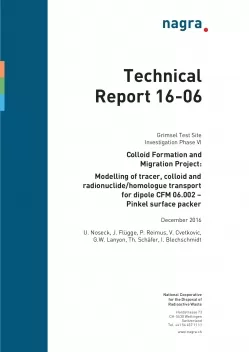
Technical Report NTB 16-06
Colloid Formation and Migration Project:Modelling of tracer, colloid and radionuclide/homologue transport for dipole CFM 06.002 – Pinkel surface packer
The Colloid Formation and Migration (CFM) project involves one of a series of experiments performed within the GTS Investigation Phase VI, which focuses on repository-relevant boundary conditions. CFM is dedicated to the study of colloid formation/bentonite erosion, the groundwater-porewater mixing zone, colloid migration and filtration, and colloid associated radionuclide transport.
The CFM field experiments are conducted within a permeable shear zone structure that has been the subject of previous tracer migration experiments (Frick et al. 1992, Smith et al. 2001, Möri 2004). The Colloid and Radionuclide Retardation Experiment (CRR; Möri 2004) focused on bentonite colloid and colloid-associated radionuclide transport. In CRR, colloid tracer tests were performed using borehole dipoles with a spacing of about 2 m and high extraction flow rates resulting in travel times of about 1 hour for conservative species. The aim of CFM has been to extend these results to longer timescales and to examine the colloid formation process under close to repository-like conditions at relatively low hydraulic gradients and flow velocities. In order to create the required flow conditions it was necessary to engineer one or more low-gradient but high-recovery controlled dipoles. This has been achieved with a novel tunnel packer system. The tunnel packer system currently in operation at the CFM site is fully described in Schlickenrieder et al. (2017).
- The free outflow from the shear zone into the tunnel is approximately 600 ml/min (Tracer Test Runs 05-01 and 06-01). Reducing the outflow from the shear zone resulted in a significantly lowered hydraulic gradient in the shear zone. Since the first tunnel sealing work, 27 tracer tests have been performed under a range of shear zone outflows and hydraulic gradients. This report describes the modelling of colloid/homologue and colloid/radionuclide tracer migration tests performed in the shear zone between the borehole CFM 06.002 and the Pinkel surface packer (main shear zone outflow point). The tests considered here are:
- Tracer Test Runs 08-01 (colloid/homologue) and 08-02 (dye): outflow 160 ml/min
- Tracer Test Run 10-01 (colloid/homologue/dye): outflow 48 ml/min
- Tracer Test Run 10-03 (colloid/homologue/dye): outflow 10 ml/min
- Tracer Test Run 12-02 (colloid/radionuclide/dye): outflow 25 ml/min
This "dipole" is also that used in the CFM Long-term In situ Test (LIT) (Schlickenrieder et al. 2017) where a solid bentonite source traced with radionuclides has been emplaced in borehole CFM 06.002 while maintaining outflow from the Pinkel surface packer. The flow boundary conditions for the LIT (25 ml/min extraction from the Pinkel surface packer) are similar to those maintained during the colloid/radionuclide Tracer Test Run 12-02. Additional colloid/radio-nuclide tracer tests within CFM have now been performed in the CRR Dipole D-1 (shear zone between CRR 99.002 and BOMI 87.010) and will be described in a future report.
The modelling presented here focuses on colloid transport and filtration and associated transport of trivalent and tetravalent homologues or radionuclides. The work was performed by three different groups using different approaches but with a similar conceptual framework and a common dataset. The groups were:
- GRS: 2D model using the d3f and r3t codes
- LANL: 1D solution in space using finite difference models and RELAP (Laplace transform solu¬tion and numerical inversion to time domain)
- KTH: 1D time-transformed solution
All groups modelled Tracer Test Runs 10-01, 10-03 and 12-02. The modelling included both blind-prediction (by GRS) and back-analysis of the test results.
The different modelling approaches all yielded qualitatively similar results in that colloid transport in the field tracer tests could be described reasonably well as a first-order filtration process, and homologue or radionuclide transport was described as being controlled by the desorption rate of solutes from the colloids.
Somewhat better fits to the colloid breakthrough curves were obtained by assuming some additional reversible filtration of the colloids. For the homologue/radionuclide desorption process, GRS considered only a single first-order desorption reaction, and the deduced rate constants were in good agreement with the other models when only a single desorption reaction was considered. However, the LANL and KTH models achieved better fits to the homologue or radionuclide breakthrough curves in several cases in which desorption from the colloids was described using a two-site adsorption model and/or when an aging reaction was allowed that results in a decreasing desorption rate with time.
A limited comparison of laboratory and field-derived desorption rate constants found that the Am and Pu rate constants estimated for Tracer Test Run 12-02 were in reasonably good agreement with the estimates obtained by Huber et al. (2011) in batch laboratory experiments involving bentonite colloids, radionuclides and fracture filling materials from the GTS shear zone.
Inconsistencies between the best-fitting descriptions of homologue or radionuclide desorption processes from colloids were identified between the different tests but the reasons are unclear. While there was a general trend of a decreasing desorption rate constant with time scale of the tests when only a one-site adsorption model was considered, the rate constant for a second site exhibited no clear pattern or trend with test time scale or other test parameters.
The desorption rate constants of the tri- and tetravalent homologues and radionuclides in the CFM tracer tests suggest that all of the homologues or radionuclides should desorb from colloids within a few months or at most a few years. This implies that colloid-facilitated transport should not be a problem over safety assessment time and distance scales. Possible approaches to better interrogating the relevant slow filtration rate constants and slow desorption rate constants are given in the report.
